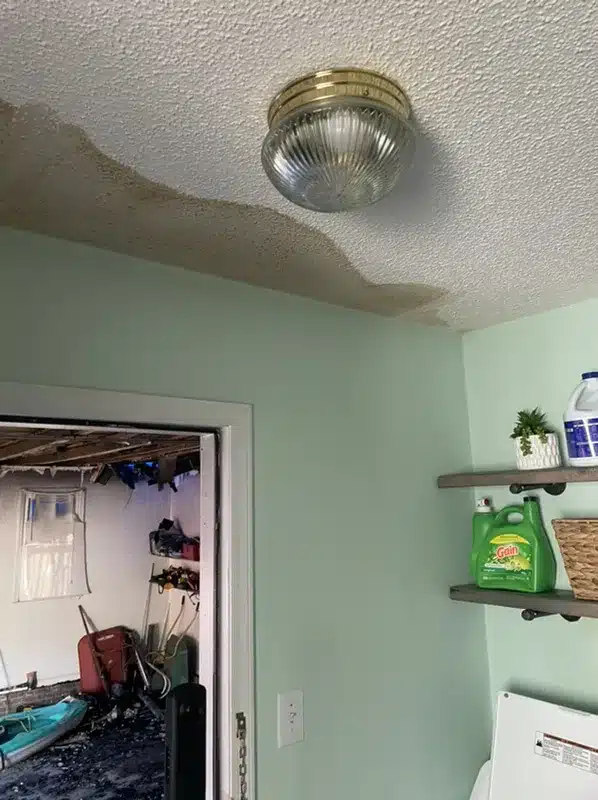Did you know water damage on a ceiling can show up in just 24 to 48 hours? In one day, things like upholstery and carpet can soak up water, getting heavy and wet. Drywall and insulation start to swell and break down too.
If ignored, mold can start growing in 48 hours, and wood can warp. After a week, your home’s structure could be badly damaged. This makes fixing it much harder and more expensive. It’s important to know how fast water damage shows up on ceilings to avoid big problems and keep your home in good shape.
Key Takeaways
- Water damage can become visible on ceilings within 24 to 48 hours.
- Early signs of water damage include swelling drywall and deteriorating insulation.
- Mold growth can start within 48 hours if water damage isn’t addressed.
- Structural integrity can be compromised if water damage persists for a week.
- Immediate action is critical to prevent extensive damage and costly repairs.
Factors Influencing Water Damage Detection on Ceilings
Several factors affect how fast water damage shows on ceilings. Knowing these helps spot water damage quickly. Let’s explore what they are.
Type of Ceiling Material
The ceiling material greatly impacts how it handles moisture. Drywall, or gypsum wallboard, quickly soaks up water. This makes it conduct electricity, which moisture meters can detect.
On the other hand, plaster is denser and holds off moisture longer. But, it’s not completely safe from damage. If exposed to water for too long, either material can weaken. Drywall might crumble, and plaster could face structural problems.
Extent of the Leak
The size of a water leak greatly affects the damage. Small leaks might not be seen right away. They keep moisture levels between 5% and 12%, which is usually okay.
But big leaks can push moisture levels over 17%. This means serious water damage and a higher risk of mold. It’s very important to check for water damage on ceilings quickly.
Humidity Levels
How humid the air is also plays a part. High humidity, over 70%, makes materials like drywall soak up moisture faster. This creates a perfect environment for mold to grow.
Mold can weaken structures and harm health. So, keeping indoor humidity in check is key to catching water damage early.
How to Identify Early Signs of Water Damage on Ceilings
Spotting water damage on ceilings early is key to avoid bigger problems and keep your home safe. Knowing the early signs can save you money and time.
Visual Indicators
Discoloration is a common sign of water damage on ceilings. Look for dark spots or patches that don’t match the ceiling’s color. Yellowish stains are also a clear warning sign.
These signs often show up before other symptoms. So, they are very important for catching damage early.
Touch and Texture
Don’t just look at the ceiling. Feel it too. If it feels damp or spongy, water might be getting in. Soft spots or unusual textures can also mean there’s moisture hidden beneath.
Noticing these changes quickly is important. It helps you find and fix the problem before it gets worse.
Mold Growth
Mold loves damp places and can grow fast after water damage. Seeing mold or mildew on your ceiling is a clear sign of water damage. It might look like black, green, or white spots and smell musty.
This smell and these spots are strong warnings. They tell you there’s a problem that needs fixing.
Water Rings and Stains
Water rings and stains are classic signs of water damage. They look like concentric circles, showing water has been there before. If you see many rings, it means the problem keeps coming back.
How long does it take for water damage to show on a ceiling?
Water damage can show up in different times, each with its own signs that need quick action. Knowing these times helps spot water damage on ceilings fast. This makes fixing it more effective.
Immediate Signs
Right after a leak starts, you’ll see signs of water damage. Look for dripping water and wet spots. Also, watch for peeling, bubbling, or flaking paint.
Small hairline cracks or bigger spiderweb patterns are signs too. Water rings, usually light brown, and mold growth in corners are also indicators. Sagging or bowed ceilings and dark or yellow stains are other signs. Musty smells are common early on.
Signs After a Few Days
After a few days, more signs of water damage appear. Ceiling materials start to swell and stay damp. Look for discoloration and stains, and peeling paint and wallpaper.
Materials swelling or warping are also signs. Spotting water damage early at this stage can stop bigger problems later.
Long-term Water Damage Indicators
Long-term exposure to water damage causes bigger issues. Look out for severe mold outbreaks and significant discoloration. Structural damage like ceiling sagging is also a sign.
Other signs include peeling or cracking paint or wallpaper. Sagging or bulging ceilings and damp odors are also indicators. Spotting these signs quickly is key to avoiding more damage, health risks, and higher repair costs.
Conclusion
Spotting water damage on a ceiling is key to avoiding big and expensive fixes. How fast you see signs of water damage depends on several things. These include the ceiling material, the size of the leak, and the humidity around it.
Knowing these factors helps homeowners act early. They can catch problems before they get worse. This means less damage and less cost in the long run.
Look out for visual signs, feel the ceiling, and watch for mold. Catching these signs early is very important. It helps fix problems quickly and keeps damage small.






